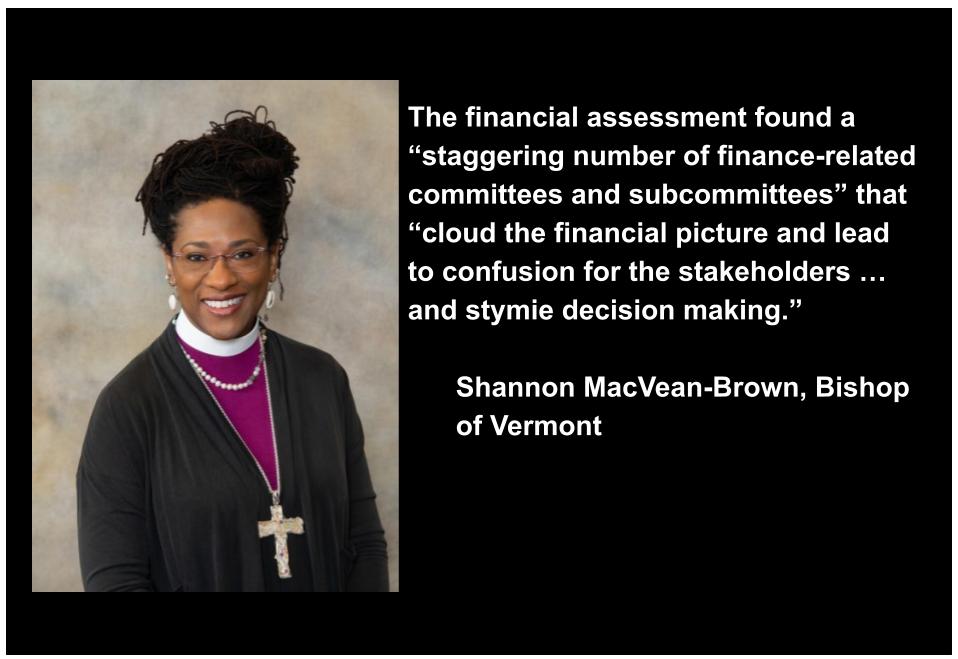The financial assessment found a “staggering number of finance-related committees and subcommittees” that “cloud the financial picture and lead to confusion for the stakeholders … and stymie decision making.”
A letter to the people of the Diocese of Vermont from the Rt. Rev. Shannon MacVean-Brown concerning the financial condition of the diocese.
Building a Bridge to the Future: A Letter from Bishop Shannon
July 21, 2021 | News & Announcements
Dear People of God in the Diocese of Vermont:
In 2018, the search committee for the 11th Bishop of Vermont wrote that in calling a full-time bishop, the diocese was taking a leap of faith “in the hopes that s/he would help us continue to discern and explore how God is speaking to us in the changes we anticipate. We don’t know what the finances will continue to look like down the road and what other creative structure of episcopacy might reveal itself in the future, but we know we are not done yet discerning what God is up to for The Episcopal Church in Vermont. It will take more time.”
Today, three years later, in the wake of a global pandemic, we know more about the diocese’s financial picture and how those realities will shape our discernment about how to participate in God’s mission. Today, I want to share with you some important news about our financial situation and outline a path forward.
Earlier this year, I contracted with Stephen Burnett to conduct a financial assessment of the diocese. Mr. Burnett, a former partner at Deloitte, was chair of the Episcopal Diocese of Atlanta’s finance committee for 27 years and has taught accounting at two Episcopal seminaries. He visited the diocese for four days in June 2021, reviewing all pertinent financial documents and meeting with me, diocesan staff, auditors and investment advisors, and diocesan leaders with budget, investment, and other financial responsibilities.
In short, his assessment revealed that a “financial cliff is on the horizon.” In his report, which was submitted to me and presented to Diocesan Council on June 16, Mr. Burnett wrote, “The Bishop envisioned financial shortfalls early on in her ministry, and we can reaffirm that there is, in fact, trouble ahead, likely in the first quarter of 2023, where, without intervention, expenditures will far exceed revenues.”
In keeping with the recommendations that are part of this financial assessment, the elected leaders of the diocese and I are taking immediate steps to restrict spending. We are leaving a vacant staff position unfilled, seeking assessment relief from the Episcopal Church, and repurposing previously restricted funds for operating expenses.
We are also working actively to create a single diocesan finance committee that will seek to overcome the barriers created by what the financial assessment called a “staggering number of finance-related committees and subcommittees” that “cloud the financial picture and lead to confusion for the stakeholders … and stymie decision making.”
However, let me be clear. Cost-cutting and streamlining alone cannot solve our diocese’s financial issues. If we were to cut expenditures enough to survive on current revenues, which are declining as our congregations grow smaller and older, we would have virtually no capacity for congregational support, social justice ministry, care of creation programs, or participation in the wider Episcopal Church—all things that the people of the diocese treasure and that are essential to God’s mission in Vermont. Cost-cutting is only a short-term survival strategy that will help us build a bridge to our new future.
To build that bridge, I have appointed a task force of lay and clergy leaders with diverse expertise and perspectives to consider how new models of ministry and new collaborative relationships might offer our diocese ways to discern our future. The members of this new group, called the Taskforce for Hope, Revitalization, Innovation, Vitality, and Efficiency (THRIVE), are listed at the bottom of this letter. They will begin meeting immediately with the hope of presenting an update to the diocesan convention on November 6.
I have also begun conversations with my colleagues in the Dioceses of New Hampshire and Maine about how our three dioceses might work together collaboratively, building shared capacity for both ministry and administration. Across the church, dioceses are realizing significant cost savings by sharing bishops and staff while retaining independent identities and governance. The task force will begin to explore these new models to learn more about the possibilities they offer for ministry in Vermont and across northern New England. I am grateful to Bishop Rob Hirschfeld of New Hampshire and Bishop Thomas Brown of Maine for their collegiality and support in these changing times.
While I know this news may come as a surprise to some of you, the challenges to the financial sustainability of our ministry were decades in the making, and we will not solve them overnight. The diocese’s leaders, my staff and I are united in our commitment to address these issues proactively and to create a strong, sustainable future by drawing on the rich stores of creativity, ingenuity and faithfulness that God has given the people of our diocese.
At last year’s diocesan convention, preaching on Matthew 14:22-34, I said that now is the time for us to “step out of the boat and go closer to Jesus.” As we embark on this work of building a sustainable future for our diocese, let us answer Jesus’ call to step outside with hope and an openness to all things new. We will surely feel the water undulating under our feet and the wind blowing in our faces, and we will surely feel unsteady. My prayer is that when this happens, we will reach out and call to Jesus to steady us. His hand is always there, ready to hold us up.
Peace and blessings,
+Shannon
Members of THRIVE:

